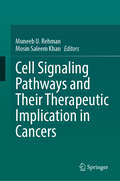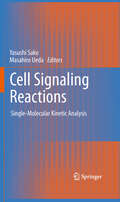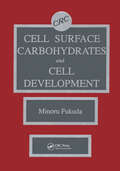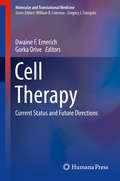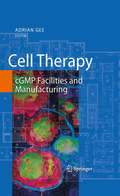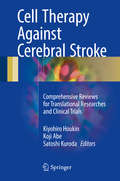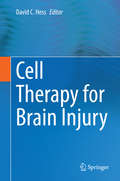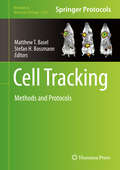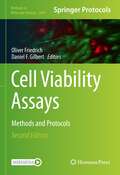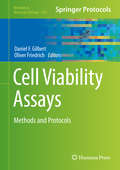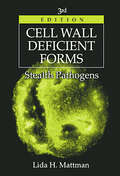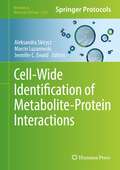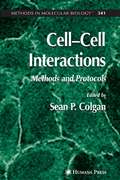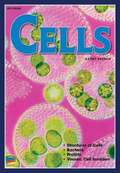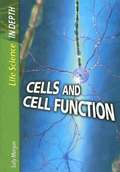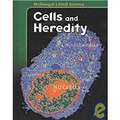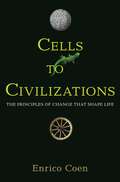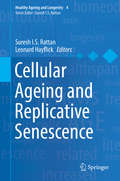- Table View
- List View
Cell Signaling Pathways and Their Therapeutic Implication in Cancers
by Muneeb U. Rehman Mosin Saleem KhanThis book discusses different signaling pathways involved in tumor development and progression. It discusses the pathways that allow tumor cells to proliferate, survive, and invade other tissues. Further, the book reviews the signal transduction regulating phagocytosis, production of cytokines, cell division, and differentiation. It elucidates the dysregulation of cellular signal transduction induced by the genetic and epigenetic changes that drive cancer and enumerates the signaling network encompassing the extracellular matrix, blood vessels, and the immune system. Additionally, the book provides mechanistic insights into inhibitors of the receptor tyrosine kinases, BRAF, EGFR, and ALK that improve clinical response and increase the survival of patients with cancer. The book covers the signal transduction pathways that regulate cell cycle progression and genomic stability, providing a mechanistic understanding of the major checkpoint pathways, and reviewing their diagnostic and therapeutic potential. This volume is essential reading for researchers to understand the therapeutic potential of important signaling molecules against cancer.
Cell Signaling Reactions: Single-Molecular Kinetic Analysis
by Masahiro Ueda Yasushi SakoThis book encompasses the exciting developments and challenges in the fast-moving and rapidly expanding research field of single-molecule kinetic analysis of cell signaling that promises to be one of the most significant and exciting areas of biological research for the foreseeable future. Cell signaling is carried out by complicated reaction networks of macromolecules, and single-molecule analyses has already demonstrated its power to unravel complex reaction dynamics in purified systems. To date, most of the published research in the field of single-molecule processes in cells, focus on the dynamic properties (translational movements of the centre of mass) of biological molecules. However, we hope that this book presents as many kinetic analyses of cell signaling as possible. Although single-molecule kinetic analysis of cellular systems is a relatively young field when compared with the analysis of single-molecule movements in cells, this type of analysis is highly important because it directly relates to the molecular functions that control cellular behavior and in the future, single-molecule kinetic analysis will be largely directed towards cellular systems. Thus, we hope that this book will be of interest to all those working in the fields of molecular and cell biology, as well as biophysics and biochemistry.
Cell Surface Carbohydrates and Cell Development
by Minoru FukudaCell Surface Carbohydrates and Cell Development summarizes knowledge on the structure and function of cell surface carbohydrates in development and differentiation. The chapters include reviews on the expression of cell type-specific carbohydrates and their roles in cell-cell interaction. In particular, the role of cell surface carbohydrates in immune cell response, malignant transformation, fertilization, and neural cell development are addressed. This includes the exciting discovery about the role of adhesive molecules in leukocyte-endothellium interaction.Cell Surface Carbohydrates and Cell Development also summarizes the latest knowledge on structure and biosynthesis of carbohydrates, the role of specific carbohydrate modification, and animal lectins. The book will be useful to researchers and students interested in the biology of glycoproteins and biotechnology.
Cell Therapy: Current Status and Future Directions (Molecular and Translational Medicine)
by Dwaine F. Emerich Gorka OriveThis volume provides a comprehensive, state-of-the art review of the field of cell therapy. The volume begins with an overview of the breadth of the field and then turns to overviews of imaging technologies that can aid in both safety and efficacy evaluations. The book then turns to numerous contributions detailing the rapidly growing field of stem cell therapies. These sections cover our understanding of the natural roles of stem cells in biology and human disease and then touches on several of the more prominent areas where stem cells are moving rapidly into clinical evaluation including neurodegenerative diseases, muscular dystrophy, cardiac repair, and diabetes. The volume concludes with contributions from experts in oncology, ophthalmology, stem cells, 3-D printing, and biomaterials where the convergence of expertise is leading to unprecedented insights into how to minutely control the in vivo fate and function of transplanted and/or endogeneously mobilized cells. Finally, the book provides insights into the pivotal relationship between academic and industrial partnerships. This volume is designed to touch on the major areas where the field will make its greatest and most immediate clinical impacts. This text will provide a useful resource for physicians and researchers interested in the rapidly changing filed of cell therapy.
Cell Therapy: cGMP Facilities and Manufacturing
by Adrian GeeCell Therapy: cGMP Facilities and Manufacturing is the source for a complete discussion of facility design and operation with practical approaches to a variety of day-to-day activities, such as staff training and competency, cleaning procedures, and environmental monitoring. This in-depth book also includes detailed reviews of quality, the framework of regulations, and professional standards. It meets a previously unmet need for a thorough facility-focused resource, Cell Therapy: cGMP Facilities and Manufacturing will be an important addition to the cell therapy professional's library. Additional topics in Cell Therapy: cGMP Facilities and Manufacturing...Standard operating procedures - Supply management - Facility equipment - Product manufacturing, review, release and administration - Facility master file.
Cell Therapy: cGMP Facilities and Manufacturing
by Adrian P. GeeThis new edition presents a fully-updated and expanded look at current Good Manufacturing Practice (cGMP) for cell therapy products. It provides a complete discussion of facility design and operation including details specific to cord blood banking, cell processing, vector production and qualification of a new facility. Several chapters cover facility infrastructure including cleaning and maintenance, vendor qualification, writing a Standard Operating Procedure, staff training, and process validation. The detailed and invaluable product information covers topics like labelling, release and administration, transportation and shipment, et al. Further chapters cover relevant topics like writing and maintaining investigational new drug applications, support opportunities in North America and the European Union, commercial cell processing and quality testing services, and financial considerations for academic GMP facilities. A chapter on future directions rounds out Cell Therapy: cGMP Facilities and Manufacturing making it essential reading for any cell therapy professional involved in the development, use, or management of this type of facility.
Cell Therapy Against Cerebral Stroke: Comprehensive Reviews for Translational Researches and Clinical Trials
by Kiyohiro Houkin Koji Abe Satoshi KurodaThis book presents comprehensive reviews for both translational research and clinical trials on cell therapy for stroke. Cerebral stroke is still a leading cause of death and disability. However, despite intensive research, few treatment options are available. The therapeutic potential of cell transplantation has been studied for various pathological conditions of the central nervous system (CNS) including traumatic brain injury, traumatic spinal cord injury, degenerative disease, demyelinating disease and ischemic stroke, as the injured neural tissue in the CNS has only a limited regenerative capacity. Recently, a growing body of evidence in this field suggests that cell transplantation holds great potential as a form of stroke therapy. The authors, who are experts in the field of neurosurgery, review and discuss optimal cell sources and various issues involved in translational research; further, they outline ongoing clinical trials in Japan.
Cell Therapy for Brain Injury
by David C. HessCell Therapy for Brain Injury is a thorough examination of using state-of-the-art cell therapy in the treatment of strokes and other traumatic brain injuries. This invaluable book covers this niche topic in depth from basic stem cell biology and principles of cell therapy through proposed mechanisms of action of cell therapy in stroke, pre-clinical data in stroke models, ongoing clinical trials, imaging and tracking of cells with MRI, neural stem cells in stroke and the "big pharma" perspective of cell therapy. Each chapter is written by well-known leaders in each field, thus providing a wealth of expertise. The breadth of this book makes it essential reading for neuroscientists, stem cell biologists, researchers or clinical trialists at pharmaceutical or biotechnology companies. It also serves as a thorough introduction for graduate students or post-doctoral fellows who hope to work in these fields.
Cell Tracking: Methods and Protocols (Methods in Molecular Biology #2126)
by Matthew T. Basel Stefan H. BossmannThis volume details methods used to track cells in the body and will serve as a reference for preclinical and clinical researchers in the fields of medicine and biomedical science. Chapters guide readers through protocols on bioluminescence imaging, fluorescence imaging, magnetic resonance imaging (MRI), ultrasound, computed tomography, and positron emission spectroscopy. Written in the highly successful Methods in Molecular Biology series format, chapters include introductions to their respective topics, lists of the necessary materials and reagents, step-by-step, readily reproducible laboratory protocols, and tips on troubleshooting and avoiding known pitfalls. Authoritative and cutting-edge, Cell Tracking: Methods and Protocols aims to ensure successful results in the further study of this vital field.
Cell Viability Assays: Methods and Protocols (Methods in Molecular Biology #2644)
by Oliver Friedrich Daniel F. GilbertThis updated edition explores assessing cell viability as a measure for cell fitness under conditions of physiological and patho-physiological stress as well as challenging conditions to cellular and tissue homeostasis, and accounts for the ongoing 2D-to-3D development with topics and assays that target cell viability, mobility, and functionality of tissues and organs, natural or bioartificial, in 3D. The book’s contents span a wide range of viability and functionality assays, from impedance spectroscopy to chemiluminescence, fluorescence and label-free optical detection methodologies. Written for the highly successful Methods in Molecular Biology series, chapters include introductions to their respective topics, lists of the necessary materials and reagents, step-by-step, readily reproducible laboratory protocols, and tips on troubleshooting and avoiding known pitfalls. Authoritative and up-to-date, Cell Viability Assays: Methods and Protocols, Second Edition serves as a valuable resource to the growing community in bioinspired life sciences, biomedical sciences, and biotechnology by providing more standardized protocols to probe the “wellbeing” of cells in various environments.
Cell Viability Assays: Methods and Protocols (Methods in Molecular Biology #1601)
by Daniel F. Gilbert Oliver FriedrichThis volume provides an overview of commonly used methods and protocols for cell fitness indicators. Chapters detail biochemical, fluorescence and luminescence-based strategies, computational, and label-free methodologies for assaying cellular viability by means of e. g. viscoelastic properties, impedance and multiphoton microscopy. Written in the highly successful Methods in Molecular Biology series format, chapters include introductions to their respective topics, lists of the necessary materials and reagents, step-by-step, readily reproducible laboratory protocols, and tips on troubleshooting and avoiding known pitfalls. Authoritative and practical, Cell Viability Assays: Methods and Protocols aims to ensure successful results in the further study of this vital field.
Cell Wall Deficient Forms: Stealth Pathogens
by Lida H. MattmanNumerous infectious diseases are described as idiopathic, meaning that "the cause is a complete mystery." For many idiopathic diseases, the causes become clear when certain techniques are applied to the patient's blood or other tissues. Cell Wall Deficient Forms: Stealth Pathogens, Third Edition describes these techniques. In the case of tuberculos
Cell-Wide Identification of Metabolite-Protein Interactions (Methods in Molecular Biology #2554)
by Aleksandra Skirycz Marcin Luzarowski Jennifer C. EwaldThis thorough volume explores protocols of proteome- and metabolome-wide strategies for the identification of protein-small molecule complexes in different organisms, in order to shed light on these important regulatory interactions. Experimental and computational strategies to characterize protein-metabolite interactions are discussed, and recent advances in enabling technologies are featured as well. Written for the highly successful Methods in Molecular Biology series, chapters include the kind of detail and expert implementation advice to ensure success in future research. Authoritative and practical, Cell-Wide Identification of Metabolite-Protein Interactions will aid researchers seeking a better understanding of the mechanisms of signal transduction occurring in the cell and assessing the effect of complex formation on cell physiology.
Cell'Cell Interactions: Methods and Protocols (Methods in Molecular Biology #341)
by Sean P. ColganA versatile collection of readily reproducible cell-cell interaction assays for uncovering cellular interactions at the molecular level, both in vitro and in vivo. The protocols cover a diverse set of cell-cell interaction models in both normal and pathological states, are readily adaptable to nearly any cell type and organ system, and include primary data and outcome analysis. In addition, the protocols follow the successful Methods in Molecular BiologyTM series format, each offering step-by-step laboratory instructions, an introduction outlining the principles behind the technique, lists of the necessary equipment and reagents, and tips on troubleshooting and avoiding known pitfalls.
Cells
by Kathy FrenchFind out about the discovery of cells, the parts of cells, the function of cells and differentiate between plant and animal cells.
Cells and Cell Function (Life Science in Depth)
by Sally MorganThese titles provide an in-depth look at life processes. The books stress key features of science teaching including scientific inquiry, use of ideas and evidence in science, planning, evaluation, and developing investigative skills. Sample experiments and data illustrate best practices in a real context. Case studies of key experiments and discoveries in the history of science are presented as box features (including modern discoveries as well as those with historical importance). Information on the most recent developments in research demonstrates the progressive nature of science.
Cells and Heredity: Module B Grades 6-8 (2018 Edition) (HMH Science Dimensions)
by Michael A. DiSpezio Marjorie Frank Michael R. HeithausNIMAC-sourced textbook
Cells and Heredity
by David M. Hillis William K. Purves Gordon H. Orians H. Craig Heller David SadavaTextbook.
Cells Are the New Cure: The Cutting-Edge Medical Breakthroughs That Are Transforming Our Health
by Robin L. SmithThe future of medicine is happening now. Revolutionary new science is providing cures that were considered science fiction just a few years ago—and not with pills, surgery, or radiation, but with human cells. Promising treatments now in extensive clinical trials could have dramatic impacts on cancer, autoimmune diseases, organ replacement, heart disease, and even aging itself. The key to these breakthroughs is the use of living cells as medicine instead of traditional drugs. Discover the advances that are alleviating the effects of strokes, Alzheimer's disease, and even allergies. Cells Are the New Cure takes you into the world of regenerative medicine, which enables doctors to repair injured and aging tissues and even create artificial body parts and organs in the lab. Cellular medicine experts Robin L. Smith, MD, and Max Gomez, PhD, outline the new technologies that make it possible to harness the immune system to fight cancer and reverse autoimmune diseases like multiple sclerosis, type 1 diabetes, and rheumatoid arthritis. CRISPR, a new technology for targeted gene editing, promises to eradicate genetic diseases, allowing us to live longer lives—possibly even beyond age 100 in good health. Cells Are the New Cure takes you on a tour of the most exciting and cutting-edge developments in medicine. The content inside these pages could save your life or the life of someone you love.
Cells in Evolutionary Biology: Translating Genotypes into Phenotypes - Past, Present, Future (Evolutionary Cell Biology)
by Brian K. Hall Sally A. MoodyThis book is the first in a projected series on Evolutionary Cell Biology, the intent of which is to demonstrate the essential role of cellular mechanisms in transforming the genotype into the phenotype by transforming gene activity into evolutionary change in morphology. This book —Cells in Evolutionary Biology — evaluates the evolution of cells themselves and the role cells have been viewed to play as agents of change at other levels of biological organization. Chapters explore Darwin’s use of cells in his theory of evolution and how Weismann’s theory of the separation of germ plasm from body cells brought cells to center stage in understanding how acquired changes to cells within generations are not passed on to future generations. The study of evolution through the analysis of cell lineages during embryonic development dominated evolutionary cell biology until usurped by the switch to genes as the agents of heredity in the first decades of the 20th century. Discovery that cells exchanged organelles via symbiosis led to a fundamental reevaluation of prokaryotic and eukaryotic cells and to a reorganizations of the Tree of Life. Identification of cellular signaling centers, of mechanisms responsible for cellular patterning, and of cell behavior and cellular condensations as mediating the plasticity that enables phenotypic change during evolution, provided powerful new synergies between cell biology and evolutionary theory and the basis for Evolutionary Cell Biology. Key Selling Features: Summarizes the long history of the essential role of cells in evolutionary change. Demonstrates that cellular processes transform genetic change into phenotypic change in development and in evolution. Documents the evidence that cells provide the missing mechanistic link between the genotype and the phenotype in evolutionary theory. Illustrates the necessity of integrating cell biology into evolutionary theory.
Cells to Civilizations: The Principles of Change That Shape Life
by Enrico CoenThe science of change from cells to cultureCells to Civilizations is the first unified account of how life transforms itself—from the production of bacteria to the emergence of complex civilizations. What are the connections between evolving microbes, an egg that develops into an infant, and a child who learns to walk and talk? Award-winning scientist Enrico Coen synthesizes the growth of living systems and creative processes, and he reveals that the four great life transformations—evolution, development, learning, and human culture—while typically understood separately, actually all revolve around shared core principles and manifest the same fundamental recipe. Coen blends provocative discussion, the latest scientific research, and colorful examples to demonstrate the links between these critical stages in the history of life.Coen tells a story rich with genes, embryos, neurons, and fascinating discoveries. He examines the development of the zebra, the adaptations of seaweed, the cave paintings of Lascaux, and the formulations of Alan Turing. He explores how dogs make predictions, how weeds tell the time of day, and how our brains distinguish a Modigliani from a Rembrandt. Locating commonalities in important findings, Coen gives readers a deeper understanding of key transformations and provides a bold portrait for how science both frames and is framed by human culture.A compelling investigation into the relationships between our biological past and cultural progress, Cells to Civilizations presents a remarkable story of living change.
Cellular Ageing and Replicative Senescence (Healthy Ageing and Longevity #4)
by Suresh I. S. Rattan Leonard HayflickThis book covers the origins and subsequent history of research results in which attempts have been made to clarify issues related to cellular ageing, senescence, and age-related pathologies including cancer. Cellular Ageing and Replicative Senescence revisits more than fifty-five years of research based on the discovery that cultured normal cells are mortal and the interpretation that this phenomenon is associated with the origins of ageing. The mortality of normal cells and the immortality of cancer cells were also reported to have in vivo counterparts. Thus began the field of cytogerontology. Cellular Ageing and Replicative Senescence is organized into five sections: history and origins; serial passaging and progressive ageing; cell cycle arrest and senescence; system modulation; and recapitulation and future expectations. These issues are discussed by leading thinkers and researchers in biogerontology and cytogerontology. This collection of articles provides state-of-the-art information, and will encourage students, teachers, health care professionals and others interested in the biology of ageing to explore the fascinating and challenging question of why and how our cells age, and what can and cannot be done about it.
